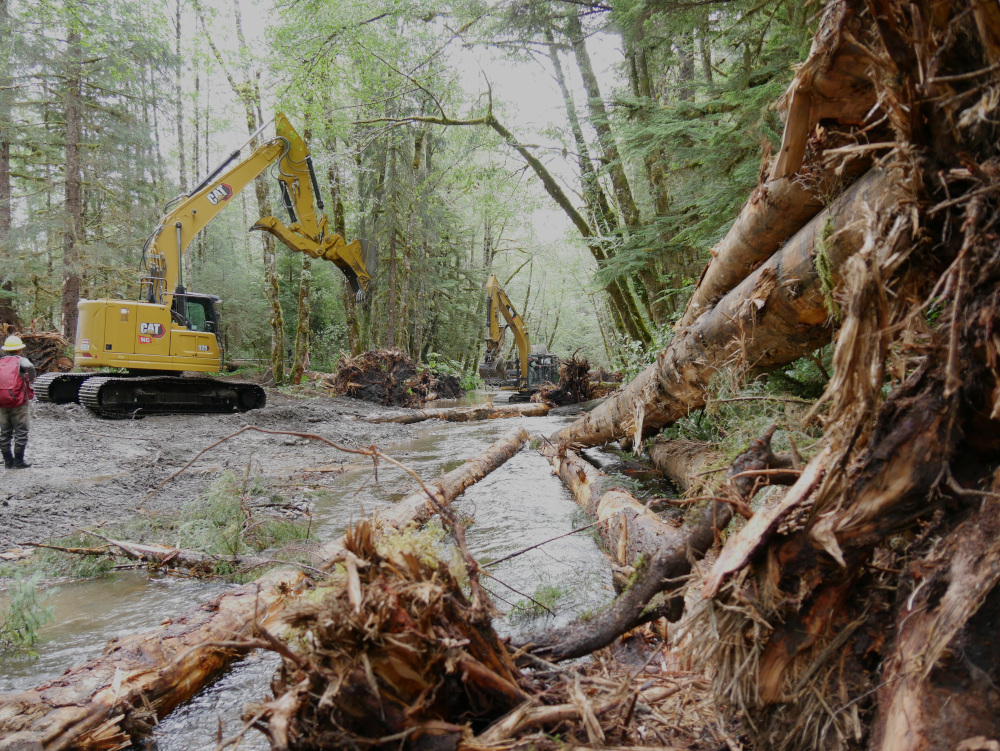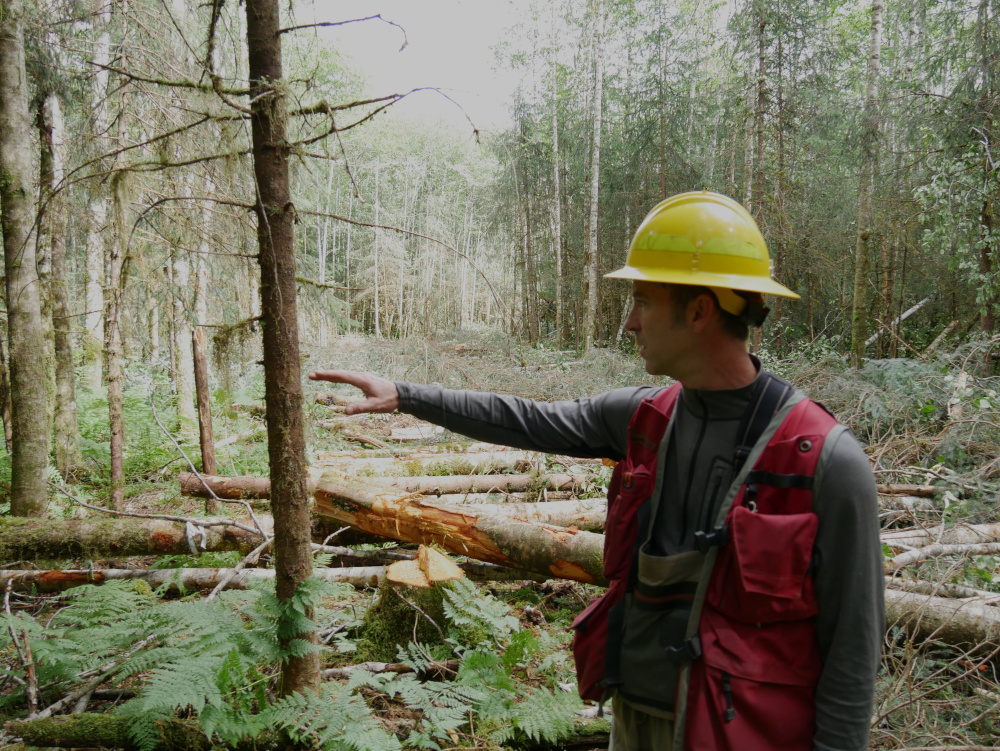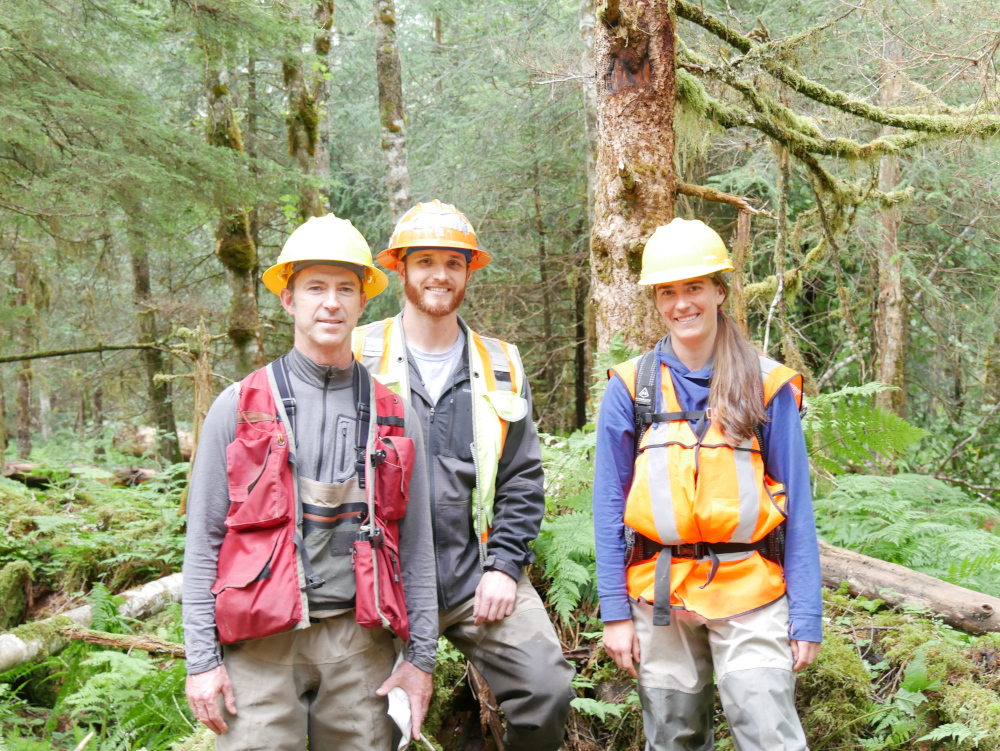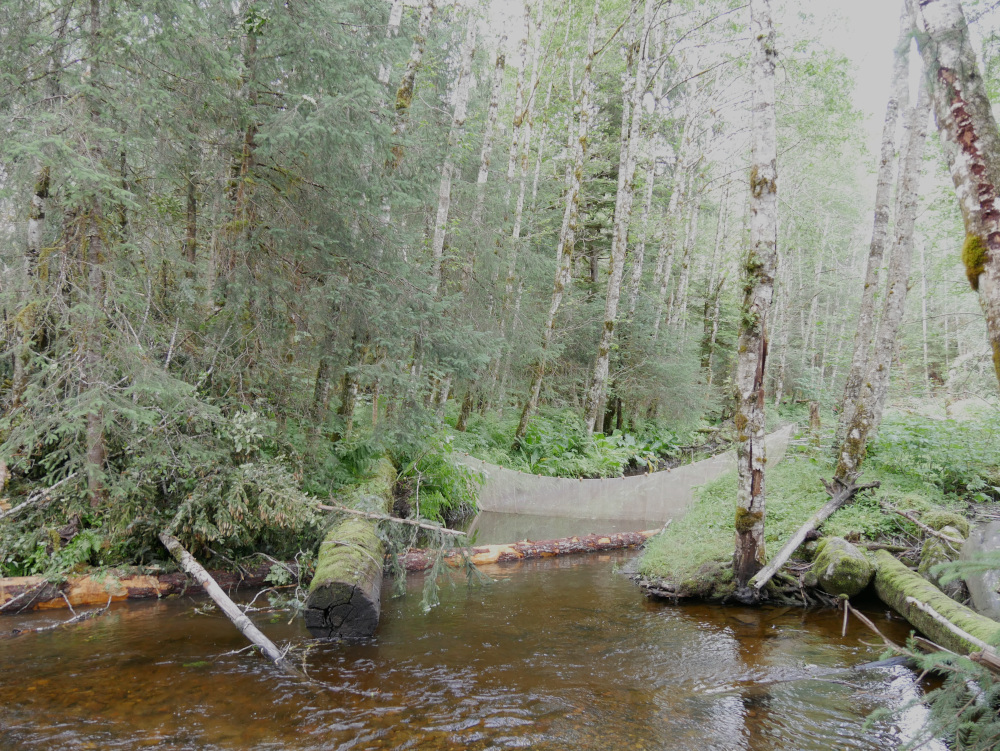
Several streams south of Petersburg are getting some major restoration work this summer. It’s hoped the repairs will mimic natural processes to bring back top soil and better fish habitat.
Two excavators dig out part of the east fork of Ohmer Creek, a salmon stream that runs under Mitkof Highway about 21 miles south of Petersburg. They’re moving huge logs, 60 to 70 feet long, many with rootwads still attached, installing them in the streambed. Six decades ago the trees along this stream were logged and many stumps removed.
“When you lose the wood out of the stream you lose the fish habitat out of the stream,” said Heath Whitacre, a hydrologist with the U.S. Forest Service. “And the hard part to overcome is you have a long time to wait until the trees that were logged in the flood plain come back to a size that will create more habitat in the future.”
This project aims to rebuild some of that fish habitat on an area of about 20 acres around east Ohmer Creek along with the north and south fork of a tributary to that called Lumpy Creek.
The Forest Service has contracted with Petersburg company Rock-N-Road Construction to cut trees and truck them in from a different part of the island. In mid-July they started building structures out of those logs, to creating new deep pools for salmon and trout.
“We’re just basically creating a structure that will create that pool,” Whitacre said. “And so we’re pinching it from the sides with large rootwads and we’re laying in other wood that will interact with the water as it gets higher and so, all that energy, all that power that comes down in the water is going to basically flush out a nice deep pool.”
Young coho salmon hold nearby in the gentle flow. It’s mid summer and the stream level is low. But the work is meant for the high water of heavy fall and winter rains, like the area saw two years ago. It’s not just instream work they’re doing. The repairs stretch out into the forest, where the water flows when the streams top they’re banks. At same time it was logged, the area was also a source of gravel for crews extending nearby Mitkof Highway. When they removed that, they also took valuable topsoil that would normally help new trees grow.
The Forest Service is partnering with the Southeast Alaska Watershed Coalition on this project. Kelsey Dean is a watershed scientist with the coalition.
“Your soil, your top soil,” Dean explained. “It’s like in your garden. There’s a lot of areas where, this happened in the 60s, and normally you would see trees be two times the size they are now but they’re really stunted in growth because they lack that topsoil, that nutrients. So in addition to the fish habitat, we’re doing some… we’re also looking to restore the flood plains and recruit that soil back in by placing large wood there so that trees can grow bigger and not be this stunted.”
The watershed coalition purchased additional wood from a local company that will be dropped into the flood plain. The project also means re-engineering part of one of the creeks to divert flow into an area that’s been cut off.

Overall the cost of the work is just over $400,000 dollars, with the money to pay for it coming from multiple sources. The Forest Service is paying around $91,000 of that. The watershed coalition pays around $120,000 dollars from a compensatory mitigation fund it has. Another $155,000 comes from federal funding for projects on National Forest Land and recommended by the Resource Advisory Committee for Petersburg, Wrangell and Kake while the Alaska Sustainable Salmon Fund pays $40,000 of the project cost.
Sig Burrell owns the Petersburg contracting company Rock-N-Road. He said it’s not the first stream restoration they’ve done for the Forest Service and they like doing the work.
“Well we’ve been working, you know we had to go harvest the trees and that,” he said. “We were out there for like three weeks and we’ll be here for about three weeks by the time we get everything done, three to four weeks. Darn near couple months of work here so.”
“I think it will last. It’ll last we’re digging them in good,” Burrell said. “We did that one out on Kuiu (Island) and one on Prince of Wales (Island). Heath and these guys know what they’re doing, tell us where to dig them in and how to build these structures.”
The Forest Service did some prior restoration work at Ohmer Creek a couple decades ago, adding some rearing ponds for smaller fish. Those are showing signs of working.

Taran Snyder is a resource specialist intern working with the Forest Service this year through a program called VetsWork Environmental, a career development program for military veterans.
He’s trapping and moving juvenile fish out of the waterway before they deepened this summer.
“So we see a density that we’re trapping in this back channel of about 85 percent coho salmon,” Snyder said. “We catch Dolly Varden, cutthroat trout, lot of sculpin as well, the bottom feeders and I have caught one steelhead, about 180 millimeter steelhead in here. Our numbers right now is we are, in the first two days of trapping we caught just shy of 400 and I’m at right now in my trapping after my first round just over 110. So more traps are the in water right now. They’ll bask for about two and half hours and I’ll go check them again.”
The crews will be building around 15 structures in the creeks and the work should be done by early August. The Forest Service will monitor the progress one year, three years and five years after. Although the benefit for tree growth may not show up for much longer.










